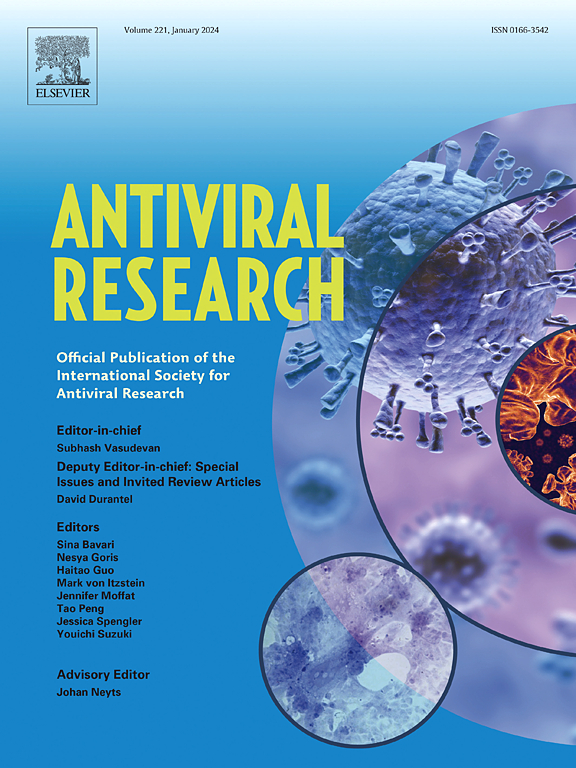Effect of antivirals on clinical and lab-adapted human cytomegalovirus strains using induced pluripotent stem cell-derived human neural models
IF 4.5
2区 医学
Q1 PHARMACOLOGY & PHARMACY
引用次数: 0
Abstract
Human cytomegalovirus (CMV) infections can cause severe neurological complications, particularly in newborns and immunocompromised patients. Children affected with congenital CMV infection may develop long-term neurological damage and intellectual disabilities. Currently, postnatal antiviral therapies are limited and there are no prenatal options available. Research on antivirals against congenital CMV infections is, at least partly, restricted due to the lack of physiologically relevant models and the use of lab-adapted CMV strains with limited clinical relevance. In this study, we evaluated the toxicity and antiviral efficacy of three FDA-approved anti-CMV drugs against two CMV strains, a clinical and a lab-adapted strain, using two human induced pluripotent stem cell (iPSC-)derived central nervous system models, viz. neural progenitor cells (NPCs) and dorsal forebrain regionalized neural organoids (RNOs). We found iPSC line-dependent differences in antiviral toxicity. We observed that antiviral treatment restored NPCs and RNOs gene expression after CMV infection and reduced CMV copy numbers. Infection of NPCs and RNOs with the clinical CMV strain, but not with the lab-adapted strain, led to an impaired expression of cortical development markers. Our findings highlight the value of using physiologically relevant human models and clinical CMV strains to understand the neuropathogenesis of congenital CMV and to test therapeutic strategies.

利用诱导多能干细胞衍生的人神经模型,抗病毒药物对临床和实验室适应的人巨细胞病毒株的影响。
人巨细胞病毒(CMV)感染可引起严重的神经系统并发症,特别是在新生儿和免疫功能低下的患者中。患有先天性巨细胞病毒感染的儿童可能会出现长期的神经损伤和智力残疾。目前,产后抗病毒治疗是有限的,没有产前选择。针对先天性巨细胞病毒感染的抗病毒药物的研究,至少在一定程度上,由于缺乏生理学相关的模型和使用实验室适应的巨细胞病毒株,临床相关性有限。在这项研究中,我们利用两种人类诱导多能干细胞(iPSC-)衍生的中枢神经系统模型,即神经祖细胞(npc)和背前脑区化神经器官(RNOs),评估了三种fda批准的抗巨细胞病毒药物对两种巨细胞病毒毒株(临床和实验室适应毒株)的毒性和抗病毒效果。我们发现了iPSC系依赖性抗病毒毒性的差异。我们观察到抗病毒治疗恢复了CMV感染后的npc和RNOs基因表达,并减少了CMV拷贝数。临床CMV毒株感染npc和RNOs导致皮质发育标志物的表达受损,而实验室适应的毒株不受感染。我们的研究结果强调了使用生理学相关的人类模型和临床巨细胞病毒株来了解先天性巨细胞病毒的神经发病机制和测试治疗策略的价值。
本文章由计算机程序翻译,如有差异,请以英文原文为准。
求助全文
约1分钟内获得全文
求助全文
来源期刊

Antiviral research
医学-病毒学
CiteScore
17.10
自引率
3.90%
发文量
157
审稿时长
34 days
期刊介绍:
Antiviral Research is a journal that focuses on various aspects of controlling viral infections in both humans and animals. It is a platform for publishing research reports, short communications, review articles, and commentaries. The journal covers a wide range of topics including antiviral drugs, antibodies, and host-response modifiers. These topics encompass their synthesis, in vitro and in vivo testing, as well as mechanisms of action. Additionally, the journal also publishes studies on the development of new or improved vaccines against viral infections in humans. It delves into assessing the safety of drugs and vaccines, tracking the evolution of drug or vaccine-resistant viruses, and developing effective countermeasures. Another area of interest includes the identification and validation of new drug targets. The journal further explores laboratory animal models of viral diseases, investigates the pathogenesis of viral diseases, and examines the mechanisms by which viruses avoid host immune responses.
 求助内容:
求助内容: 应助结果提醒方式:
应助结果提醒方式:


